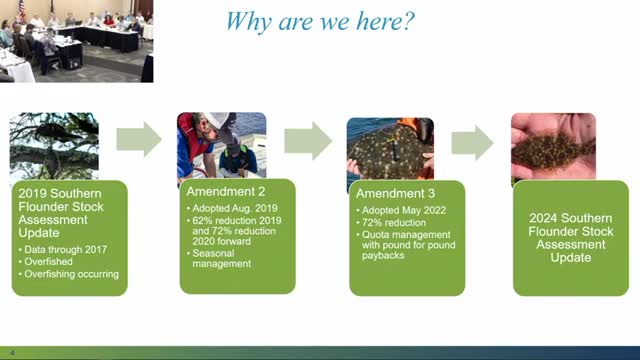Southern flounder stock faces critical overfishing crisis
August 23, 2024 | Marine Fisheries, State Departments and Agencies, Organizations, Executive, North Carolina
This article was created by AI summarizing key points discussed. AI makes mistakes, so for full details and context, please refer to the video of the full meeting. Please report any errors so we can fix them. Report an error »

In a recent government meeting, officials discussed the alarming status of the Southern Flounder stock, revealing that it remains overfished and continues to experience overfishing. The latest assessment, which incorporates data through 2022, indicates that the stock is significantly below the established thresholds for sustainability, with spawning stock biomass at just 1,019 metric tons—well below the target of 5,689 metric tons.
The meeting highlighted the implications of the Fisheries Reform Act (FRA), which mandates that North Carolina must end overfishing within two years and restore the stock to sustainable levels within ten years. To address the crisis, Amendment 2 was adopted in August 2019, requiring a 62% reduction in total removals in 2019 and a 72% reduction from 2020 onward. Amendment 3, passed in May 2022, introduced quota management and continued the 72% reduction in removals.
Despite these measures, the assessment shows no significant signs of recovery. Recruitment indices, which measure the abundance of young fish, have declined, and the age structure of the population remains skewed towards younger fish, with few older individuals present. This lack of older fish is critical, as it indicates insufficient spawning potential to rebuild the stock.
The meeting also underscored that the overfishing issue is not confined to North Carolina; neighboring states, including South Carolina, Georgia, and Florida, are facing similar challenges. The officials emphasized the need for a comprehensive approach to management across state lines, as the Southern Flounder stock is shared among these regions.
Looking ahead, the next stock assessment is not expected until at least 2027, with potential management changes not anticipated until 2029. This timeline raises concerns about the long-term viability of the Southern Flounder population and the effectiveness of current management strategies. The officials acknowledged that more time is needed to evaluate the impact of recent regulations, as it typically takes a full generation of the species—approximately four years—to assess the success of management actions.
As the meeting concluded, the urgency of addressing the Southern Flounder crisis was clear, with officials calling for continued monitoring and adaptive management strategies to ensure the sustainability of this vital fishery.
The meeting highlighted the implications of the Fisheries Reform Act (FRA), which mandates that North Carolina must end overfishing within two years and restore the stock to sustainable levels within ten years. To address the crisis, Amendment 2 was adopted in August 2019, requiring a 62% reduction in total removals in 2019 and a 72% reduction from 2020 onward. Amendment 3, passed in May 2022, introduced quota management and continued the 72% reduction in removals.
Despite these measures, the assessment shows no significant signs of recovery. Recruitment indices, which measure the abundance of young fish, have declined, and the age structure of the population remains skewed towards younger fish, with few older individuals present. This lack of older fish is critical, as it indicates insufficient spawning potential to rebuild the stock.
The meeting also underscored that the overfishing issue is not confined to North Carolina; neighboring states, including South Carolina, Georgia, and Florida, are facing similar challenges. The officials emphasized the need for a comprehensive approach to management across state lines, as the Southern Flounder stock is shared among these regions.
Looking ahead, the next stock assessment is not expected until at least 2027, with potential management changes not anticipated until 2029. This timeline raises concerns about the long-term viability of the Southern Flounder population and the effectiveness of current management strategies. The officials acknowledged that more time is needed to evaluate the impact of recent regulations, as it typically takes a full generation of the species—approximately four years—to assess the success of management actions.
As the meeting concluded, the urgency of addressing the Southern Flounder crisis was clear, with officials calling for continued monitoring and adaptive management strategies to ensure the sustainability of this vital fishery.
View full meeting
This article is based on a recent meeting—watch the full video and explore the complete transcript for deeper insights into the discussion.
View full meeting
